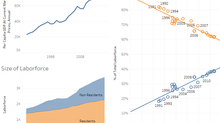Singapore in Numbers - Population size & composition trends

The first line of the 2020 Singapore Population Census highlights that the population has been growing at a compounded average growth rate (CAGR) of 1.1% of the last 10 years; from 5.08M in 2010 to 5.69 in 2020. And during this time, the percentage residents has dropped from 74.2% in 20201 to 71.0% in 2020. As the percentage of residents shrunk, the number of permanent residents dropped as well. But did this all happen suddenly due to the pandemic or were these trends already there. but we didn't notice till this report?

Singapore's population has been growing at an average of 2% annually since 1970. However, the make up of the population has changed tremendously since then. The Singapore population was 90% citizens and 6% PRs in 1970; citizens make up only 61% of the population as at 2020, with PRs making up another 9%. Much of the population growth has been with Non-Residents
The census report indicates that the population CAGR was 1.1% over the last 10 years. When compared against the 40 year average of 2%, it could appear to be significant drop. Changes especially over long periods of time are sometimes hard to understand, appreciate and contextualize. Singapore's population changes went through an arc; which corresponds to Singapore journey of economic development. Singapore's 10 year population CAGR was low at the start, when Singapore was facing challenges attracting talent and investment for growth, but in Singapore's hey-day (1990-2000) the 10 year CAGR was as high as 2.83%. As a high income country on a tiny island, it would be tenable for Singapore's population to continue to grow at such a pace. New labour policies implemented in 2015 intended to curb reliance on foreign labour further contributed to the reduction.

And the impact of the policy can be observed since then, were the growth rates of non-residents dropped significantly. And no surprise that we even observed a reduction in the number of non-residents and even in 2020 when the COVID19 restrictions were in place and many businesses were struggling. Such reductions among the non-resident population is not unusual in times of economic crisis, it has happened many times before (SARS, global financial crisis etc.).
The Singapore population census was never intended to address all possible questions about the population, but FYT is glad that it gave us the opportunity to have objective discussed about what we see in the data. In FYTs humble opinion, we noted 3 key observations
The slower population growth trend were already there, but it was further exacerbated by the pandemic
The reduction in non-resident labour is also not unusual; this is a direct response to poor business conditions in Singapore and around the world. However, the question is how the Singapore economy responds after the pandemic to attract global talent back to Singapore
The reduction in the number of Permanent Residents is worth noting. On the assumption of the relatively constant number of new citizens each year, this suggest that there could be a reduction in demand Singapore PR applications; which could have serious implications on Singapore's ability to compete on talent in the future.
This one data point doesn't tell the whole story. We will explore more in the next segment; in the meantime, you can explore FYTs data visualizations at https://public.tableau.com/views/SGpopulationStructure2020/Populationoverview?:language=en-US&:display_count=n&:origin=viz_share_link
(All analysis is based on data from Singapore's Department of Statistics)

























Comentários